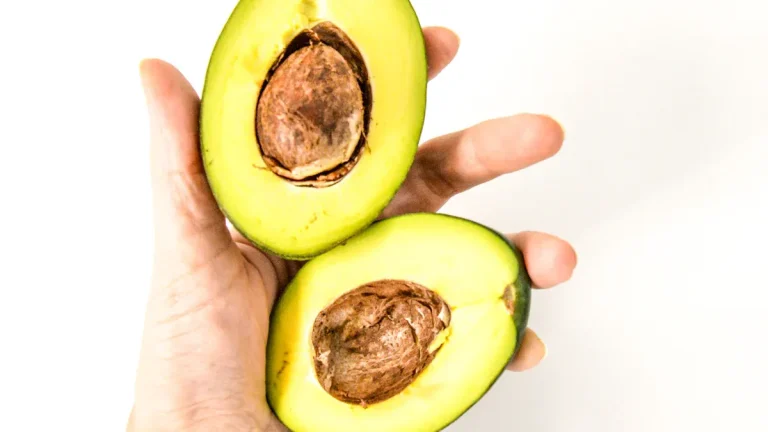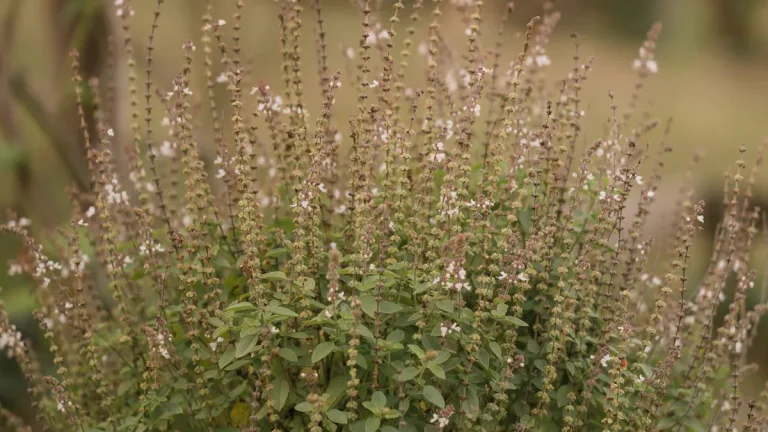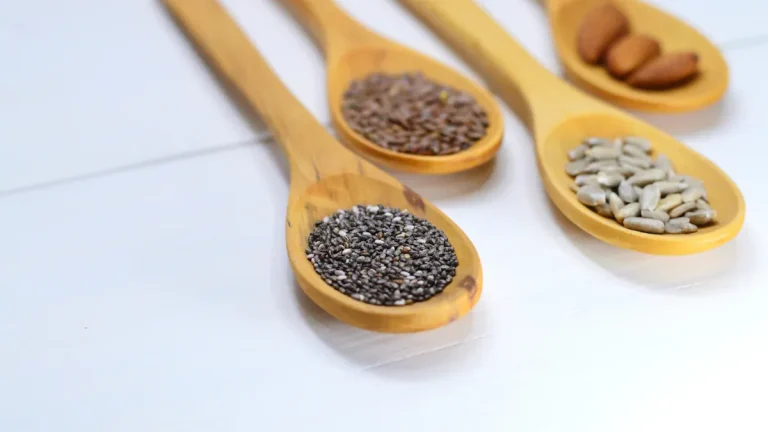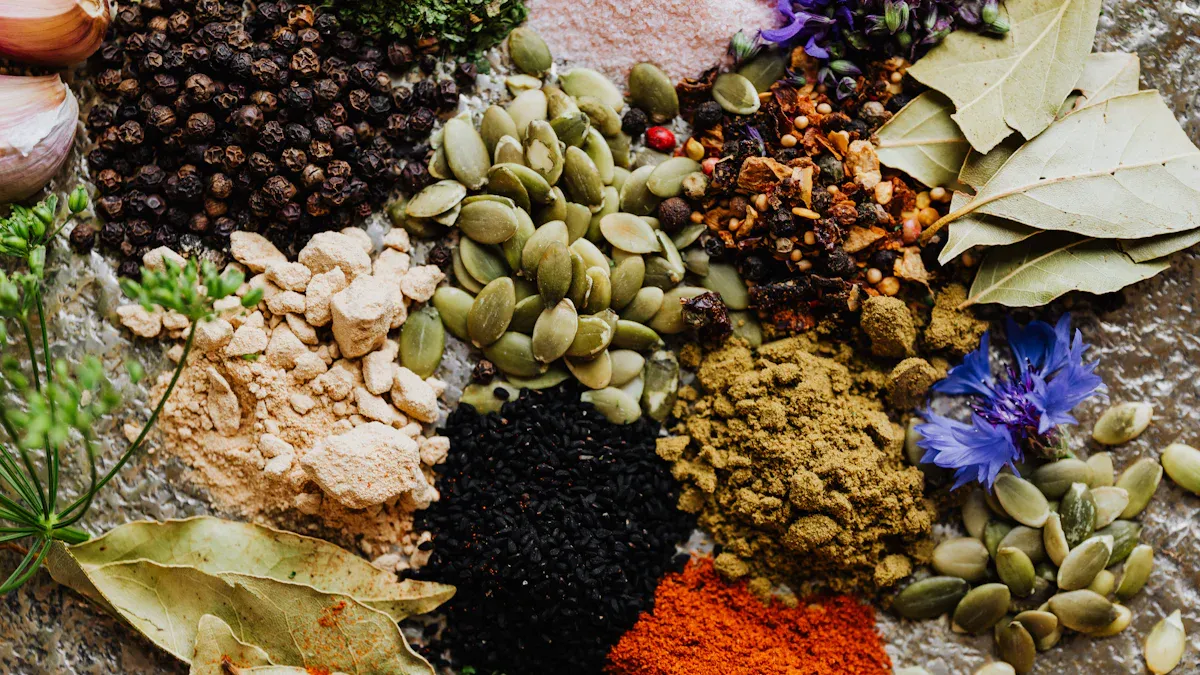
You probably keep a few herbs and spices in your kitchen, but do you know how many ways they boost flavor, health, and cooking? Here’s a quick look at 30 must-have types of herbs: garlic powder, cinnamon, cumin, ginger, nutmeg, onion powder, oregano, mint, rosemary, basil, cardamom, chili, chives, coriander, dill, turmeric, parsley, thyme, peppermint, sage, bay leaf, tarragon, marjoram, lemongrass, fennel, anise, allspice, cloves, paprika, and star anise.
Most herbs do more than taste good—scientists found that 84% of common herbs and spices studied, like thyme, oregano, rosemary, basil, mint, turmeric, and ginger, offer anti-inflammatory effects and may lower your risk of chronic health problems. Understanding the types of herbs and how they blend with different foods helps you create meals that are both tasty and good for your health.
Key Takeaways
Explore a variety of herbs and spices to enhance flavor and boost health in your meals.
Use fresh herbs like basil and mint for vibrant taste and health benefits in salads and drinks.
Incorporate spices like garlic powder and cinnamon to add depth and support heart health in your cooking.
Store herbs and spices properly in cool, dark places to maintain their flavor and health properties.
Experiment with homemade spice blends to control quality and freshness while enjoying exciting flavors.
Types of Herbs and Spices
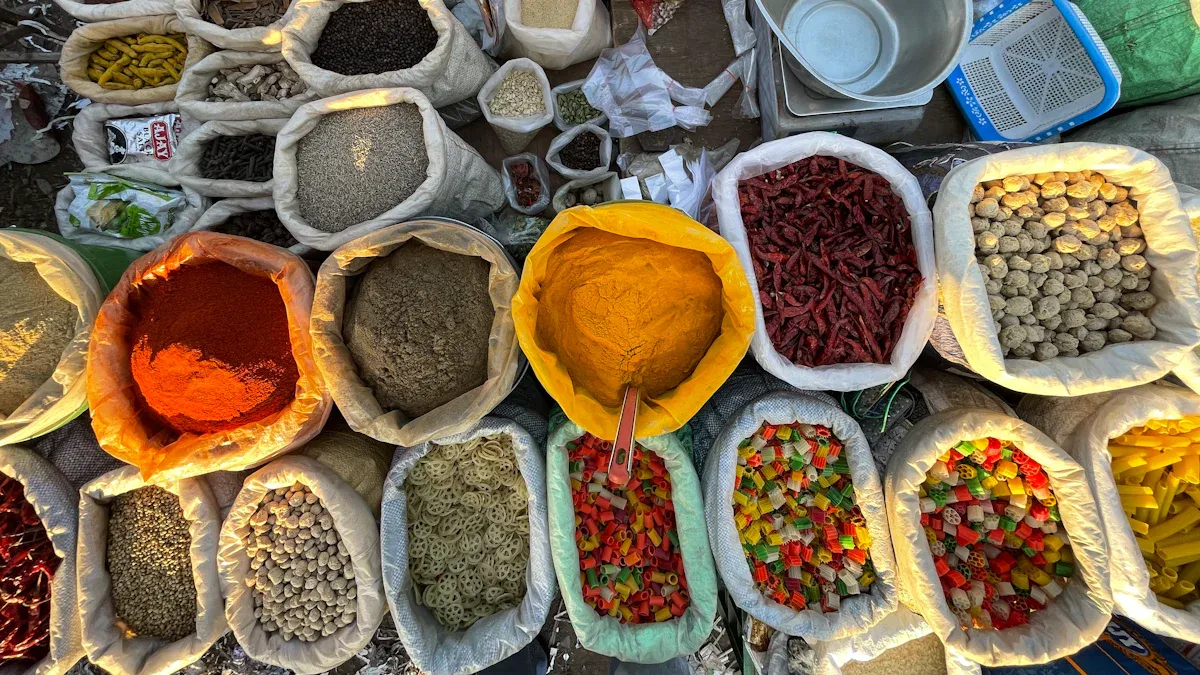
Essential Herbs
When you open your spice cabinet, you probably see a mix of fresh culinary herbs and dried blends. You might wonder what makes some herbs essential for flavor and health. Let’s look at the types of herbs you’ll want to keep handy.
Basil
You taste basil in Italian pasta sauces, Thai curries, and fresh salads. This herb brings a sweet, peppery flavor. Basil can help support healthy cholesterol levels.Mint
Mint gives drinks, desserts, and salads a cool, refreshing taste. You find it in Middle Eastern recipes and herbal teas. Mint is a favorite for soothing your stomach.Rosemary
Rosemary has a strong, pine-like flavor. You use it in meats, soups, and roasted vegetables. Rosemary may help reduce stress and boost your mood.Parsley
Parsley adds a fresh, grassy note to soups, salads, and sauces. It’s one of the most common herbs and spices worldwide. Parsley contains vitamin K, which supports bone health.Oregano
Oregano tastes earthy and slightly bitter. You sprinkle it on pizza, pasta, and grilled vegetables. Oregano is packed with antioxidants that help fight inflammation.Thyme
Thyme brings a subtle, lemony flavor. You use it in stews, poultry, and vegetable dishes. Thyme supports your immune system and may help with coughs.Chives
Chives taste mild and onion-like. You chop them into eggs, potatoes, and dips. Chives contain vitamin C and help boost your immune health.Dill
Dill gives pickles, fish, and salads a fresh, tangy flavor. Dill can help with digestion and may ease bloating.Sage
Sage has a savory, earthy flavor. You use it in stuffing, sausages, and roasted meats. Sage may improve memory and support brain health.Peppermint
Peppermint is cool and sweet. You find it in desserts, drinks, and herbal teas. Peppermint can help relieve headaches and digestive discomfort.
Tip: Always wash fresh culinary herbs before using them. This keeps your dishes safe and flavorful.
Essential Spices
You can’t talk about types of herbs without mentioning must-have dried spices. These spices add depth, warmth, and health benefits to your meals.
Garlic Powder
Garlic powder gives a savory kick to soups, sauces, and marinades. Garlic acts as a natural antibiotic and immune booster. It helps lower blood pressure and supports heart health.Cinnamon
Cinnamon tastes sweet and spicy. You sprinkle it on oatmeal, smoothies, and baked goods. Cinnamon may lower blood sugar and support brain health.Cumin
Cumin adds a warm, earthy flavor to chili, curries, and stews. Cumin helps with digestion and may improve blood cholesterol.Ginger
Ginger brings a zesty, spicy flavor. You use it in teas, stir-fries, and baked treats. Ginger helps with nausea and supports immune health.Nutmeg
Nutmeg tastes sweet and nutty. You add it to desserts, sauces, and holiday drinks. Nutmeg supports digestion and may help with sleep.Onion Powder
Onion powder gives a mild, savory flavor to dips, dressings, and rubs. It’s a staple in many kitchens for quick flavor.Paprika
Paprika tastes sweet or smoky, depending on the type. You use it in stews, meats, and rice dishes. Paprika is one of the top herbs and spices used globally.Black Pepper
Black pepper adds heat and depth to almost any dish. It’s the most widely used spice in the world. Black pepper helps with digestion and boosts nutrient absorption.Cardamom
Cardamom tastes sweet and floral. You find it in chai, baked goods, and curries. Cardamom supports heart health and freshens breath.Chili Powder
Chili powder brings heat and color to tacos, soups, and sauces. It’s rich in vitamin C and may help boost metabolism.
Note: Don’t add too many different herbs or spices to one dish. You want to highlight the flavor enhancing properties of each ingredient.
Flavorful Herbs and Spices List
You might wonder which types of herbs and spices stand out for their flavor and health benefits. Here’s a list of 30 functional and flavorful herbs and spices you’ll want to explore:
Garlic powder
Cinnamon
Cumin
Ginger
Nutmeg
Onion powder
Oregano
Mint
Rosemary
Basil
Cardamom
Chili powder
Chives
Coriander
Dill
Turmeric
Parsley
Thyme
Peppermint
Sage
Bay leaf
Tarragon
Marjoram
Lemongrass
Fennel
Anise
Allspice
Cloves
Paprika
Star anise
Did you know? Black pepper, paprika, parsley, and basil are the most widely used herbs and spices around the world.
Let’s see how some of these flavorful herbs and spices compare for antioxidant content:
Herb/Spice | Antioxidant Content (mmol/100 g) |
|---|---|
Clove | 465 |
Peppermint | 277 |
Allspice | 200 |
Cinnamon | 150 |
Oregano | 44 |
Thyme | 44 |
Sage | 44 |
Rosemary | 44 |
Saffron | 44 |
Estragon | 44 |
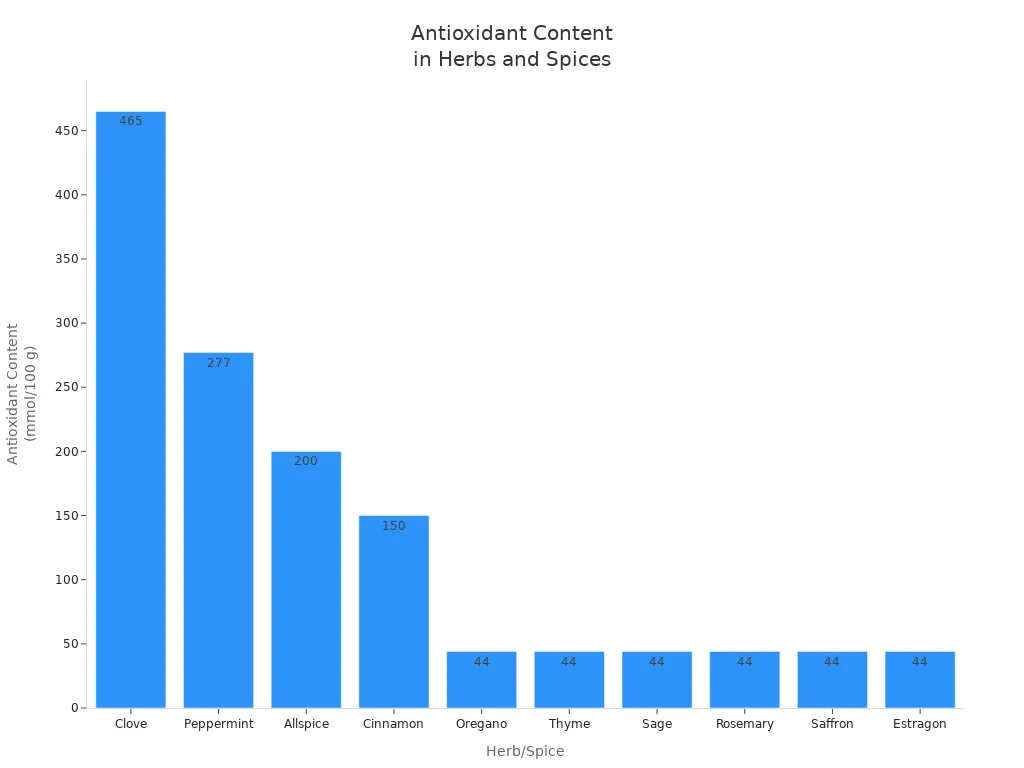
Clove stands out for its high antioxidant and phenolic content. You get powerful health benefits when you add clove to your recipes. Peppermint and cinnamon also rank high for antioxidants, making them smart choices for both flavor and wellness.
You see how culinary herbs like basil, mint, and rosemary bring unique flavors to your meals. They also offer health benefits, from supporting cholesterol to reducing stress. You can use fresh culinary herbs for salads and garnishes, or try must-have dried spices for soups and stews.
Callout: Cultural traditions shape the types of herbs and spices you find in different cuisines. West African stews use peanuts and greens, while North African tagines feature complex spice blends. Trade routes and local customs influence which top herbs and spices appear in your favorite dishes.
You might make mistakes with herbs and spices if you don’t know the difference between fresh and dried, forget to wash fresh herbs, or add them at the wrong time. Measuring your herbs and knowing which ones work best for your recipe helps you get the most flavor and health benefits.
You can enjoy flavorful herbs and spices in herbal teas, baked goods, and savory dishes. Try combining different types of herbs to create new flavor profiles and boost your health. The world of culinary herbs and spices is full of possibilities for cooking and wellness.
Herbs vs. Spices
Key Differences
You might wonder what sets herbs apart from spices. Both come from plants, but they have different roles in your kitchen and for your health. Here’s a quick look at what makes each unique:
Criteria | Herbs | Spices |
|---|---|---|
Plant Part | Green leafy parts (leaves, shoots, flowers) | Non-leafy parts (seeds, roots, bark, etc.) |
Plant Type | Usually from herbaceous plants | Can come from trees, shrubs, vines, etc. |
Usage | Used liberally in cooking | Used sparingly due to potency |
Flavor Profile | Subtle, grassy, floral | Bold, deep, warm |
Examples | Parsley, basil, rosemary | Cinnamon, pepper, garlic |
Herbs usually come from the soft, green parts of plants. You use them fresh or dried to add a gentle touch to your meals. Spices come from seeds, roots, bark, or fruit. They bring strong flavors and often a burst of color. Both herbs and spices can boost your health in different ways.
You also get different nutrients from herbs and spices.
Herbs often have more minerals, which help your body stay strong.
Some spices, like cumin and celery seed, have more sodium, so you might want to check labels if you watch your salt.
Seeds give you extra phosphorus, which supports your bones.
Why Both Matter for Flavor
You need both herbs and spices to make your food taste great and support your health. Herbs add freshness and color. Spices bring warmth and depth. When you use both, you create balanced meals that don’t rely on salt alone for flavor.
Herbs and spices help you enjoy low-salt meals by making them more interesting.
They balance saltiness, acidity, fat, and bitterness in your dishes.
You get more health benefits when you mix different herbs and spices.
Here’s a table showing what some common herbs and spices can do for your health:
Herb/Spice | Health Benefit(s) |
|---|---|
Clove | High in antioxidants, may lower blood sugar and cholesterol |
Rosemary | Contains compounds that fight inflammation |
Cinnamon | May help with inflammation and lower blood sugar |
Garlic | Contains allicin, which may lower heart disease risk |
Turmeric | Known for anti-inflammatory and antioxidant effects |
Ginger | May help digestion and reduce nausea |
Chili Pepper | Contains capsaicin, which may boost metabolism and support heart health |
Cumin | Rich in iron, may help with weight loss |
Fenugreek | May help regulate blood sugar |
Oregano | Contains antioxidants that may protect against chronic diseases |
You can see that herbs and spices do more than add flavor. They support your health in many ways. Try using a mix of both in your meals to get the best of taste and wellness.
Flavor Pairings and Uses
Fresh Herbs in Cooking
You can transform your meals by cooking with herbs and spices. When you use fresh herbs, you add bursts of flavor and health benefits. You might toss fresh parsley into soups for a green, vibrant taste. Bay leaves give stews a subtle, distinctive flavor. Chives work well as a garnish, offering a mild onion-like flavor. Oregano brings warmth and a Mediterranean touch. Fresh basil pairs perfectly with tomato soup. Thyme adds earthy depth to dishes. Paprika gives color and a mild, sweet flavor. Black pepper adds complexity. Fresh ginger provides a spicy zing. Using more herbs and spices in your cooking helps you create meals that taste fresh and support your health.
Tip: Always add fresh herbs near the end of cooking. This keeps their flavor and health benefits strong.
Dried Spices in Cooking
Dried spices play a big role in both sweet and savory dishes. You use them to add depth and health benefits. In baked goods, spices like cinnamon and nutmeg balance sweet flavors and enhance fruits and nuts. In savory cooking, cumin and paprika add warmth and color. Smell your spices before using them. If they lack aroma, they may not give your dish the best flavor. You should store spices in a dark place, in airtight containers, away from moisture and heat. Grind whole spices when needed for maximum freshness and health.
Storage Tip | Description |
|---|---|
Store in a dark place | Protects spices from light degradation. |
Store in airtight containers | Prevents moisture and air exposure. |
Keep spices away from moisture | Reduces the risk of spoilage. |
Grind whole spices when needed | Ensures maximum freshness and flavor. |
Keep spices away from heat | Preserves their potency and aroma. |
Flavorful Herbs and Spices Pairings
Pairing herbs and spices with the right foods makes your cooking shine. For chicken, garlic works well and smoked paprika adds smoky flavor. Lemon peel gives brightness. Turkey tastes great with cumin and sage. Seafood pairs with dried lemon zest, lemongrass, and dill weed. You can use more herbs and spices with tomatoes and vegetables for extra health and flavor.
For sweet dishes, you can try angelica for a fruity garnish, basil for citrus notes, bergamot for a tea-like flavor, lavender for a floral touch, mint for a refreshing taste, lemon balm for sweetness, and rosemary for poaching fruits.
Dish Type | Herb/Spice Pairing | Description |
|---|---|---|
Chicken | Garlic | Complements chicken well. |
Chicken | Smoked Paprika | Adds smoky flavor and color. |
Chicken | Lemon Peel | Provides citrusy brightness. |
Turkey | Cumin | Earthy and nutty, great for dark meat. |
Turkey | Sage | Traditional herb for turkey. |
Seafood | Dried Lemon Zest | Tart flavor that enhances shrimp. |
Seafood | Lemongrass | Bright flavor, pairs well with shellfish. |
Seafood | Dill Weed | Herbaceous flavor that complements halibut. |
Callout: Mixing fresh herbs with dried spices lets you create sweet or savory profiles. Try new combinations to boost both flavor and health in your cooking.
Storage and Growing Tips
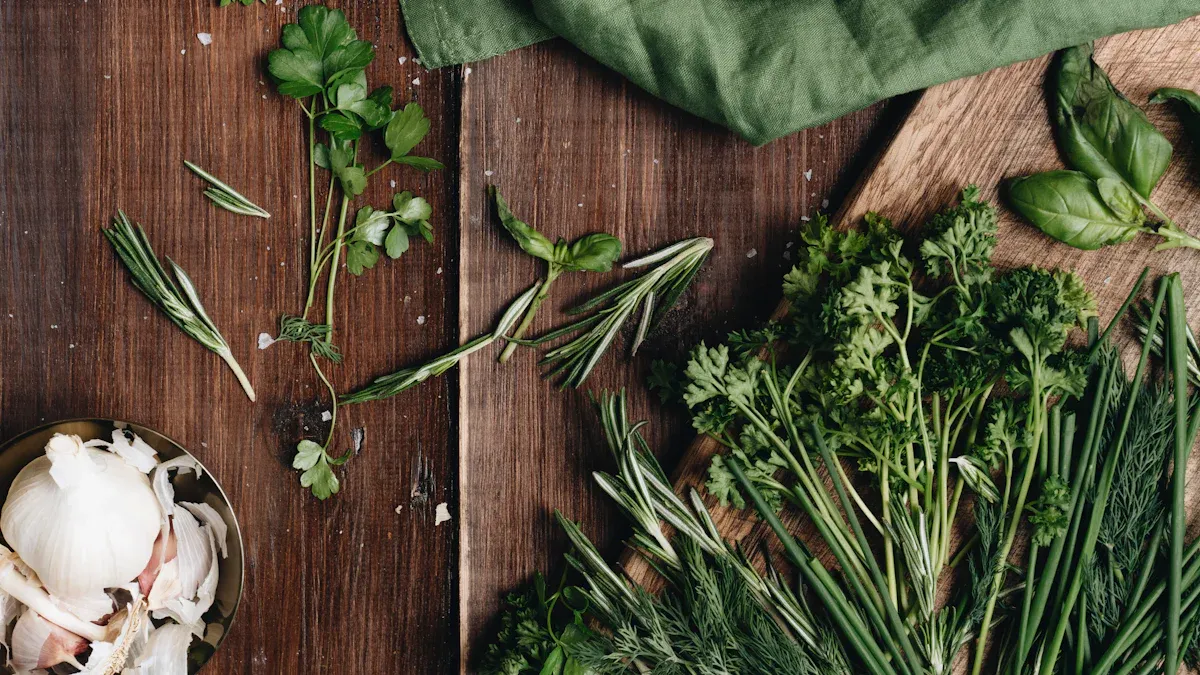
Storing Herbs and Spices
You want your herbs and spices to keep their health benefits and flavor as long as possible. Store dried herbs fully dry in airtight containers. Keep them in a cool, dark place, away from heat and moisture. Try to keep the temperature below 75 degrees Fahrenheit. Avoid direct sunlight, which can break down the health properties of your herbs and spices. For fresh herbs, wrap them in a damp paper towel and place them in a container in the fridge. This helps them stay crisp and full of health benefits.
Here’s how long you can expect your herbs and spices to last when stored right:
Type of Herb/Spice | Shelf Life |
|---|---|
Dried Herbs | 1–3 years |
Ground Spices | 2–3 years |
Whole Spices | Up to 4 years |
Tip: If your herbs or spices lose their smell or color, it’s time to replace them for the best health and flavor.
Using Herbs and Spices Daily
You can add herbs and spices to almost every meal for better health. Try mint in salads or drinks for a sweet, fresh taste. Basil works well in pasta and even desserts. Parsley brightens up rich dishes and boosts your health. Sprinkle spices like cinnamon or cumin on roasted veggies or in soups. Add a pinch of turmeric to smoothies for extra health support. Using herbs and spices every day makes your cooking more exciting and helps you get more health benefits.
Mint: Great in salads and drinks.
Basil: Perfect for pasta and desserts.
Parsley: Enhances rich dishes.
Cinnamon: Adds warmth to breakfast.
Cumin: Boosts soups and stews.
Growing Herbs at Home
You can grow many herbs at home, even if you have little space. Basil, parsley, and mint are some of the easiest herbs to start with. Use containers with good drainage and keep the soil slightly moist. Basil likes sun and warmth. Mint grows well in a pot and needs regular pruning. Parsley does best in moist, rich soil and can handle both sun and shade. Try growing oregano, chives, rosemary, thyme, and dill for more variety. Growing your own herbs gives you fresh options for cooking and supports your health. Remember to use sustainable methods to protect the environment and keep your herbs healthy.
Easy Recipes and Blends
Quick Recipes
You can find many quick recipes that use a mix of herbs and spices for better health and taste. These recipes show what you can make when you want something fast and full of flavor. Here are some popular choices:
Sage Blueberry Collins uses sage for a fresh twist in drinks.
Spicy Strawberry Rhubarb Margarita adds ginger for a spicy kick.
Turmeric Ginger Lemonade mixes turmeric and ginger for a healthy, bright drink.
Strawberry Basil Lemonade brings basil into a sweet, fruity recipe.
Spinach Salad with Jicama, Black Beans, & Lime Vinaigrette uses cumin and chili powder for a bold salad.
Southwest Seasoning Mix blends cumin, chili powder, oregano, smoked paprika, coriander, and cayenne pepper for a zesty flavor.
Tomato Jam combines ginger, cumin, and cinnamon for a sweet and spicy spread.
Citrus Salsa uses cilantro for a fresh topping.
Herb Sauce mixes mint, cilantro, and ginger for a bright sauce.
Homemade Barbecue Sauce uses chili powder, cinnamon, cumin, paprika, cayenne pepper, and mustard powder for a smoky taste.
Homemade Tomato Sauce with Mushrooms features thyme, rosemary, bay leaf, and oregano for a rich flavor.
Chili Cauliflower Chickpea Tacos with Mango Salsa uses chili powder, paprika, cumin, and cilantro for a spicy taco.
Indian Spiced Chicken brings together cumin, cinnamon, ginger, turmeric, mint, and cilantro for a flavorful meal.
Summer Shakshuka uses cumin, turmeric, paprika, parsley, and za’atar for a healthy breakfast.
These recipes show what you can do with herbs and spices in your daily cooking. They help you enjoy more health benefits and keep your meals interesting.
Herb/Spice | Nutritional Benefits |
|---|---|
Parsley | Rich in Vitamin C and antioxidants; freshens breath |
Oregano | Contains antibacterial and antiviral properties |
Cilantro | Complements dishes and has antioxidant properties |
Turmeric | Contains curcumin, known for cancer-fighting properties |
Mint | Acts as a digestive aid and has antioxidant potential |
Cinnamon | Helps stabilize blood sugars and has antimicrobial effects |
DIY Spice Blends
You can make your own spice blends at home for better health and flavor. Here are some of the most popular blends for everyday cooking:
Spice Blend | Key Ingredients | Uses |
|---|---|---|
Italian Blend | Chili powder, garlic powder, onion powder, cayenne pepper, paprika, oregano, salt, pepper | Tacos, fajitas, grilled meats |
BBQ Dry Rub | Brown sugar, paprika, cayenne pepper, garlic powder, onion powder, salt, pepper | Grilling or smoking meats |
Curry Blend | Turmeric, cumin, coriander, cinnamon, dry mustard, cayenne pepper, parsley, salt, pepper | Curry dishes, roasted vegetables, soups |
What makes homemade blends special? Grinding spices just before you use them gives you the strongest flavor. You can also change the mix to fit your taste. Homemade blends use fresher herbs and spices, which can boost health. Store-bought blends may have additives or lose flavor over time. When you make your own, you control the quality and freshness. Whole spices keep their flavor longer, so your blends stay strong and healthy.
Tip: Try making small batches of blends so you always have fresh herbs and spices for your recipes.
You can unlock the health benefits of herbs and spices every day. Research shows that adding a variety of herbs and spices to your meals brings health benefits beyond basic nutrition. You get more health and wellness when you use herbs and spices in your cooking.
You boost health by exploring new herbs and spices.
You improve wellness by trying different combinations.
You discover health benefits with every meal.
Nutrition experts say herbs and spices add flavor without extra fat or calories. You can start with small amounts and store herbs and spices the right way for lasting health benefits.
Try new blends and recipes. You will enjoy better health, more wellness, and exciting flavor in your cooking.
FAQ
What are the main differences between herbs and spices?
You find herbs from the leafy parts of plants. Spices come from seeds, roots, or bark. Both add flavor and boost your health. You use herbs for fresh taste. Spices give dishes warmth and depth.
What health benefits do herbs and spices offer?
You get antioxidants, vitamins, and minerals from herbs and spices. These help your body fight illness and support heart health. Some spices may lower blood sugar. Many herbs help with digestion and boost your immune system.
What types of spices should you keep in your kitchen?
You want to keep garlic powder, cinnamon, cumin, paprika, and chili powder. These spices work in many recipes. They add flavor and support your health. You can use them in soups, stews, and sauces.
What is the best way to use herbs for health?
You add fresh herbs to salads, soups, and drinks. This gives you more vitamins and antioxidants. You can chop parsley, mint, or basil for extra health benefits. Fresh herbs make your meals taste better and help your body.
What makes spices important for health?
You get strong flavors and health support from spices. Turmeric, ginger, and cinnamon help fight inflammation. Spices can make food taste great without extra salt or fat. You improve your health by using different spices every day.

